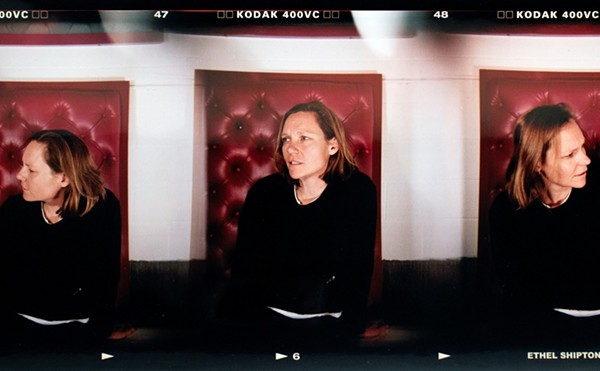Of the many photography shows in Fotoseptiembre this year, one of the most compelling is Laura McPhee’s “River of No Return” on view at Southwest School of Art. A visit to the school’s Navarro Campus galleries will show you why this exhibition of landscape photography set attendance records when it showed at Boston’s Museum of Fine Arts. The color photographs, 6-by-8-foot C-prints, are ginormous, and so is Idaho’s Sawtooth Valley, the desolate location they document.
The Nez Perce called the Salmon River that flows through Idaho “The River of No Return” because the water’s rapid current made it easy to get down, but almost impossible to get back up. When McPhee lugged her heavy Deardorff 8-by-10-inch viewfinder camera across the valley’s rough terrain, she must have felt at times that she was on an upstream journey, weighted down as she was with antique gear. Built in the 1950s, her camera is similar to those used by famed landscape photographer Ansel Adams, but McPhee uses it to strikingly different effect. Adams (and his many imitators) portrayed landscape as untouched wilderness, not a human in sight. Though his stupendous scenes are impressive, their pristine perfection has led some detractors to delegate the style as “nature porn.”
In contrast McPhee’s photos, like updated Hudson River School paintings, celebrate the pastoral relation of man and nature. But the world on view here is not backward looking; this is powerful art without nostalgia. If it belongs to a movement, call it rural contemporary.
The works are highly formal, sometimes verging on the abstract. But these are not just visual exercises. Human presence is always seen in the photograph, sometimes revealed cryptically. Two images in the hallway outside the galleries are paired, matching a diagonal right-to-left movement in each work. The photo on the left pictures a dark snow-filled night, the wood poles of a barbed wire fence eerily lit by yellow light. The title, “Snowmobile Headlights, Valley Road, Custer County, Idaho, 2004,” reveals the hidden light source. In the companion piece “One Car Passing, Valley Road, Sawtooth Valley, Idaho, 2003” a line of floating dust hides the vehicle that made it, and the road as well.
There is also smoke, and fire as well. This is forest fire territory. Smoke billows like low-flying cumulous clouds in one photograph; in another it plays hide-and-seek with the viewer, a small plume barely noticeable above distant mountain ridges. Small flames, like errant campfires, shine up from the forest floor in a dark copse of woods that seems lit by magic, beams of light pass through green branches merging downcast light with smoke from the burn. But man’s presence in the mountains doesn’t always lead to destruction; the fires may well have been caused by lightening, but the photographer’s arrival to the scene is joined by firefighters.
One of the most striking photographs in the show is an image of green pastures under dark storm clouds, lines of craggy purple mountains deepen the scene, which is wonderfully balanced by another blue mass — a plastic tarp in the foreground. The reason for its casual presence is unknown, but it seems to illuminate the nearby white flowers, completing the composition.
How do people live in this almost empty, but not quite, terrain? Gold and silver mining disrupted the lifeways of the Nez Perce and Shosone when prospectors arrived in 1857. The mines played out shortly after the strike at Custer Mill in 1879, but ranching continues. In one of the few photographs with figures, a man stands in front of a truck that seems to have been airlifted onto a mountain top; a woman smiles down at him from the cab. Signs of ranching are also seen in what seems at first as a typical woodland scene of birch trees. Closer inspection, however, reveals names and dates cut in the bark, graffiti in the wild, marking territory like its urban variants.
Plans for schools from rural parts of Texas to visit the exhibition are in the works. I hope they’re successful. This is a too-rare opportunity for farm kids to see an aesthetic vision that respects and understands their world. •
River of No Return
Free
9am-5pm Mon-Sat,
11am-4pm Sun
Southwest School of Art
Navarro Campus
300 Augusta St
(210) 224-1848
swschool.org
On view through November 20















